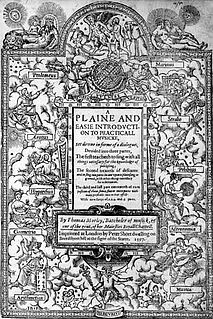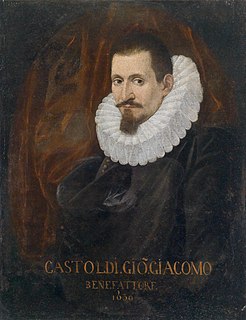Related Research Articles

John Dowland was an English or possibly Irish Renaissance composer, lutenist, and singer. He is best known today for his melancholy songs such as "Come, heavy sleep", "Come again", "Flow my tears", "I saw my Lady weepe" and "In darkness let me dwell", but his instrumental music has undergone a major revival, and with the 20th century's early music revival, has been a continuing source of repertoire for lutenists and classical guitarists.

A pastoral lifestyle is that of shepherds herding livestock around open areas of land according to seasons and the changing availability of water and pasture. It lends its name to a genre of literature, art, and music (pastorale) that depicts such life in an idealized manner, typically for urban audiences. A pastoral is a work of this genre, also known as bucolic, from the Greek βουκολικόν, from βουκόλος, meaning a cowherd.

A madrigal is a secular vocal music composition of the Renaissance and early Baroque (1600–1750) eras. The polyphonic madrigal is unaccompanied, and the number of voices varies from two to eight, but usually features three to six voices, whilst the metre of the madrigal varies between two or three tercets, followed by one or two couplets. Unlike the verse-repeating strophic forms sung to the same music, most madrigals are through-composed, featuring different music for each stanza of lyrics, whereby the composer expresses the emotions contained in each line and in single words of the poem being sung.
"The Passionate Shepherd to His Love", known for its first line "Come live with me and be my love", is a poem written by the English poet Christopher Marlowe.

Luca Marenzio was an Italian composer and singer of the late Renaissance.
The English Madrigal School was the brief but intense flowering of the musical madrigal in England, mostly from 1588 to 1627, along with the composers who produced them. The English madrigals were a cappella, predominantly light in style, and generally began as either copies or direct translations of Italian models. Most were for three to six voices.

Thomas Morley was an English composer, theorist, singer and organist of the Renaissance. He was one of the foremost members of the English Madrigal School. Referring to the strong Italian influence on the English madrigal, The New Grove Dictionary of Music and Musicians states that Morley was "chiefly responsible for grafting the Italian shoot on to the native stock and initiating the curiously brief but brilliant flowering of the madrigal that constitutes one of the most colourful episodes in the history of English music."
Thomas Tomkins was a Welsh-born composer of the late Tudor and early Stuart period. In addition to being one of the prominent members of the English Madrigal School, he was a skilled composer of keyboard and consort music, and the last member of the English virginalist school.

The Triumphs of Oriana is a book of English madrigals, compiled and published in 1601 by Thomas Morley, which first edition has 25 pieces by 23 composers. It was said to have been made to honour Queen Elizabeth I. Every madrigal in the collection contains the following couplet at the end: “Then sang the shepherds and nymphs of Diana: long live fair Oriana” though some of the composers wrote variants of this refrain.

Giovanni Giacomo Gastoldi was an Italian composer of the late Renaissance and early Baroque periods. He is known for his 1591 publication of balletti for five voices.

Henry Walpole was an English Jesuit martyr, executed at York for refusing to take the Oath of Supremacy.
Barley-Break is an old English country game frequently mentioned by the poets of the 17th and 18th centuries. It was played by three pairs, each composed of a man and a woman, who were stationed in three bases or plots, contiguous to each other. The couple occupying the middle base, called hell or prison, endeavoured to catch the other two, who, when chased, might break to avoid being caught. If one was overtaken, he and his companion were condemned to hell. From this game was taken the expression "the last couple in hell", often used in old plays.
John Bennet was a composer of the English madrigal school. Little is known for certain of Bennet's life, but his first collection of madrigals was published in 1599.

In English early Baroque music, a broken consort is an ensemble featuring instruments from more than one family, for example a group featuring both string and wind instruments. A consort consisting entirely of instruments of the same family, on the other hand, was referred to as a "whole consort", though this expression is not found until well into the seventeenth century. The word "consort", used in this way, is an earlier form of "concert", according to one opinion, while other sources hold the reverse: that it comes from the French term concert or its Italian parent term concerto, in its sixteenth-century sense. Matthew Locke published pieces for whole and broken consorts of two to six parts as late as 1672.

The Oxford Book of English Madrigals was edited by Philip Ledger, and published in 1978 by the Oxford University Press. It contains words and full music for some 60 of the madrigals and songs of the English Madrigal School.
John Mundy was an English composer, virginalist and organist of the Renaissance period.
My bonny lass she smileth is a famous English ballett, written by Thomas Morley and published in 1595 in his First Book of Balletts to Five Voices. A ballett was the English form of the Italian balletto, a light, homophonic, strophic song for three or more singers, distinguished by dance-like rhythms and "fa-la-la" refrains. It is based on an Italian madrigal, published by Gastoldi in 1591. The ChoralWiki gives the following words for the two opening verses.

Early music of Britain and Ireland, from the earliest recorded times until the beginnings of the Baroque in the 17th century, was a diverse and rich culture, including sacred and secular music and ranging from the popular to the elite. Each of the major nations of England, Ireland, Scotland, and Wales retained unique forms of music and of instrumentation, but British music was highly influenced by continental developments, while British composers made an important contribution to many of the major movements in early music in Europe, including the polyphony of the Ars Nova and laid some of the foundations of later national and international classical music. Musicians from the British Isles also developed some distinctive forms of music, including Celtic chant, the Contenance Angloise, the rota, polyphonic votive antiphons, and the carol in the medieval era and English madrigals, lute ayres, and masques in the Renaissance era, which would lead to the development of English language opera at the height of the Baroque in the 18th century.
Nationality words link to articles with information on the nation's poetry or literature.
References
- ↑ Phillip Ledger (ed) The Oxford Book of English Madrigals (1978) Oxford University Press, and co-issued recording, by Pro Cantione Antiqua
- ↑ MacMahon, Desmond (1939) Nelson's New National and Folk Song Book; pt. II. London: Thomas Nelson; pp. 114-15
- ↑ "Renaissance Love Songs Study Guide" by Prof. Paul Brians at Washington State University